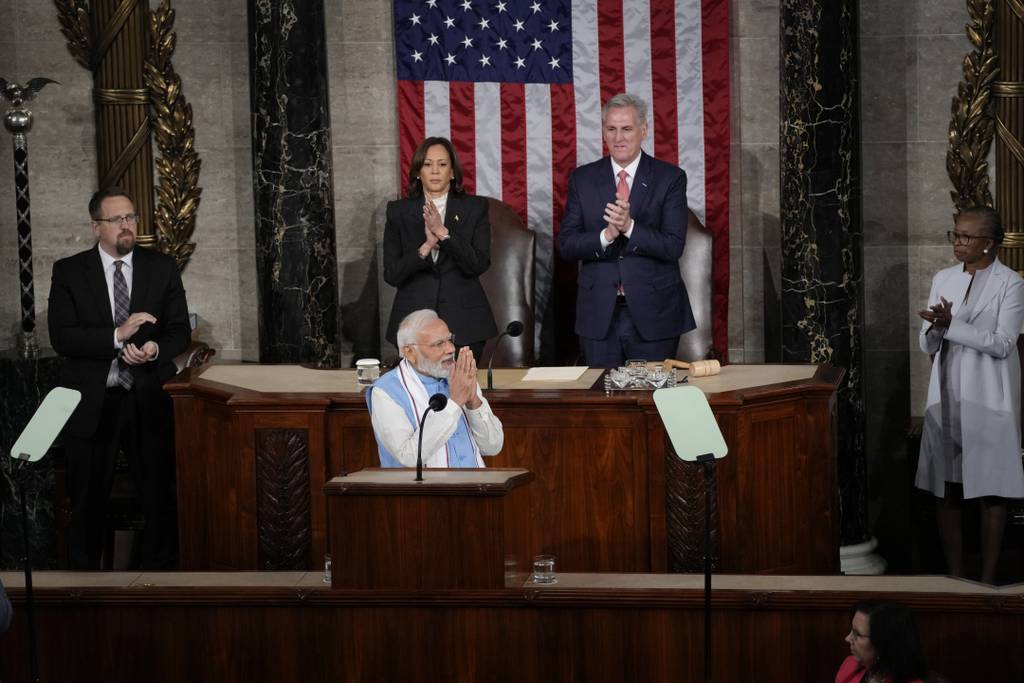
The U.S. and India unveiled several defense cooperation initiatives on Thursday during Prime Minister Narendra Modi’s state visit, deepening a strategic partnership forged by shared geopolitical goals but beset by human rights concerns raised by members of Congress.
The new deals, totaling billions, span a number of key industries — including semiconductors, aerospace, and artificial intelligence.
Modi touted the partnership in his Thursday address to a joint meeting of Congress.
“The United States has become one of our most important defense partners,” Modi said, triggering a standing ovation. “When defense and aerospace in India grow, industries in the states of Washington, Arizona, Georgia, Alabama, South Carolina and Pennsylvania thrive.”
But government officials and activists raised concerns about the Modi administration. Approximately 70 Democratic lawmakers, led by Sen. Chris Van Hollen (D-Md.) and Rep. Pramila Jayapal (D-Wash), signed a letter Monday urging the Biden administration to make human rights a centerpiece of the week’s negotiations. The cohort criticized the “rise of religious intolerance, the targeting of civil society organizations and journalists and growing restrictions on press freedoms and internet access” across the subcontinent.
Several Democratic lawmakers — including Reps. Alexandria Ocasio-Cortez of New York, Rashida Tlaib of Michigan and Ilhan Omar of Minnesota — boycotted the speech, citing Modi’s human rights record. Modi was welcomed by those who did attend; call-and-response cries of “Jai Hind”—”Long Live India”— rang from the Senate chamber’s upper deck as Modi left the room and some members of Congress sought Modi’s autograph after his speech.
In mid-May, India’s Central Bureau of Investigation jailed Defense News contributor Vivek Ranghuvashi on unspecified espionage charges. White House and Pentagon officials skirted questions about Raghuvanshi’s detention this week, while the National Press Club issued a statement stating it was “deeply concerned about [his] arrest and detention.”
Modi did not acknowledge the crackdown when asked about it by a reporter at the White House, instead hailing India’s democratic credentials. Biden also avoided a similar question, noting “an overwhelming respect for each other because we’re both democracies.”
Raghuvanshi would likely have covered a number of high-profile deals unveiled this week. India agreed to procure $3 billion worth of MQ-9B SeaGuardian drones. GE Aerospace said it would partner with Indian flight tech company Hindustan Aeronautics to produce fighter jet engines for the Indian Air Force.
Micron Technology, an American semiconductor firm, pledged to spend upwards of $2.75 billion on construction of an assembly and test facility in India. Meanwhile, the two powers kickstarted negotiations for a reciprocal defense procurement arrangement to coordinate the exchange and development of military technology.
The day before Modi’s address, Indian and American bureaucrats along with executives from startups and defense contractors congregated for a daylong conference at the U.S. Chamber of Commerce to network and showcase new tech in the hopes of facilitating “joint innovation on defense technologies and accelerate the integration of India’s budding private sector defense industry with the U.S. defense sector,” according to the White House.
Overlapping strategic concerns and growing economic incentives are drawing the once distant powers together. Both are wary of Chinese aggression in the Indo-Pacific (though the Biden administration has shied away from mentioning Beijing explicitly during Modi’s visit). The U.S. is also keen to distance India from Russia, the country’s leading arms supplier. New Delhi, meanwhile, is eager to develop an organic defense industry of its own.
The recent slate of agreements builds on decades of summits and signings. Bush administration officials and their Indian counterparts penned a “U.S.-India Defense Relationship” framework in 2005, setting out mutual priorities and areas of cooperation. A series of subsequent economic agreements culminated in the pair’s first strategic dialogue in 2010, as then-President Barack Obama ushered in the American “Pivot to Asia.”
Obama consecrated India as a “major defense partner” during the prime minister’s last full-fledged state visit to Washington in 2016. The U.S. began sharing advanced military communications technology with New Delhi two years later.
The QUAD, an informal security collective including India, Japan, Australia and the U.S., held its first meeting in 2021. Earlier this year, India and the U.S. launched the “Initiative on Emerging and Technology” to streamline the exchange of military technology and expertise.
Jaime Moore-Carrillo is an editorial fellow for Military Times and Defense News. A Boston native, Jaime graduated with degrees in international affairs, history, and Arabic from Georgetown University, where he served as a senior editor for the school’s student-run paper, The Hoya.
Bryant Harris is the Congress reporter for Defense News. He has covered U.S. foreign policy, national security, international affairs and politics in Washington since 2014. He has also written for Foreign Policy, Al-Monitor, Al Jazeera English and IPS News.
- SEO Powered Content & PR Distribution. Get Amplified Today.
- EVM Finance. Unified Interface for Decentralized Finance. Access Here.
- Quantum Media Group. IR/PR Amplified. Access Here.
- PlatoAiStream. Web3 Data Intelligence. Knowledge Amplified. Access Here.
- Source: https://www.defensenews.com/congress/2023/06/23/us-india-cement-partnership-with-slew-of-new-defense-deals/



